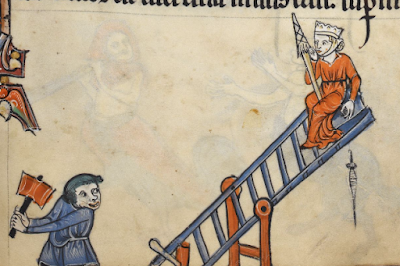Recently, I've been quite focused on hand spinning with the distaff and spindle after I found the hypothesis of Cathelina di Alessandri at 15th Century Spinning. With some gorgeous reproduction spindles from Katrin Kania (reviewed here), I've learnt Cathelina's method, experimented with some alterations, spread it to my reenactment group and now we appear to be corrupting fellow reenactors and modern crafters alike at a slightly terrifying rate...
Hence, we now have a FaceBook group for spreading the idea of distaff spinning in reenactment and crafting and for coming together and sharing ideas, hints, tips, new information, etc.
You can find us at The Evangelical Church of Distaff Spinning (yes, it has a silly name ^_^).
And I'll now leave you with a fascinating image: the only image of a top-whorl spindle I know of that's from medieval Western Europe. It even looks like it might have a little hook at the top.
 |
| Woman spinning flax (?) with distaff and spindle whilst on ducking stool (?). Rutland Psalter (British Library, Add. MS 62925), f. 86r. England (London?), c. 1260. Source. |
What about you? What have you been focusing on this season? Have you tried spinning with distaff and reproduction spindles? Have you seen any other interesting medieval spinning images?
Ive been telling reenactors these past twenty years to use a bloomin distaff. I've never seen a single image of any period,medieval or classical, of a womanspinning without a distaff. when you tell people it will improve their spinning they just shrug and say they never use the thread for anything, I despair sometimes
ReplyDeleteAmen!
DeleteThe funny thing is we've convertied some modern hobby spinners not just reenactors. It really is a very intuitive method once you've been shown it.